I hate it that I am overpowered by an addiction to porn and compulsive masturbation. I don’t understand why I just can’t stop it. I really loathe that part of myself. It disgusts me. Can you help?
You and millions of other people, millions MORE now that the internet has invaded our lives!
I serve on the board of Living Hope Ministries, a Christ-centered outreach to those wanting to leave homosexuality. I asked Ricky Chelette, a pastor of First Baptist Church of Arlington (TX) and Executive Director of Living Hope, to share his highly understandable explanation of what happens in an addictive cycle, in a way that has also helped many people dealing with their various besetting sins. He graciously gave me permission to offer his material to answer your question. I hope it helps.
Sue Bohlin
Probe Ministries
Understanding The Cycle of Sin
This is the cycle of sin that I often share with folks that meet with me. Though I designed this visual image for overcomers with same gender attraction (SGA), I have used it with my single adult group as a whole, for I feel the concepts are universal though the vehicles we use to accomplish our end result might be somewhat different.
Take a look at this diagram.
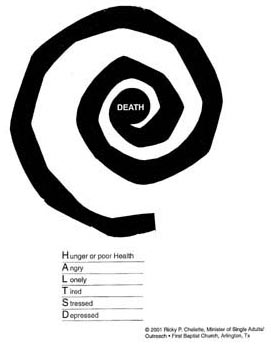
You begin the cycle of sin at the bottom of the page where you see the letters and blank lines.
Though many of you think that what triggers you is the sight of a good looking man/woman, I think something much deeper is taking place. Most of our triggers fall into one of these broad categories:
- Health
I am talking about bad health. When you are sick you are open to temptation.
- Hunger
When we are hungry we can feel temptation.
- Angry
- Lonely
Need I say more…
- Tired
- Stressed
- Depressed
Whenever we feel one of these feelings or something closely related to one or more of them, we have the thought of RELIEF. We all want relief from the pain, hurt and stresses of our lives.
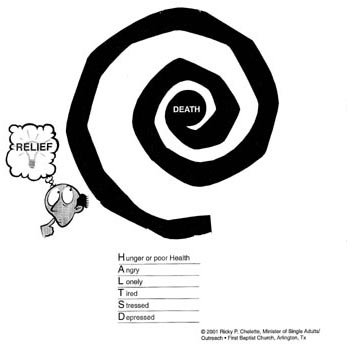
The way that we find relief is to seek some form of medication. This does not have to be actual medication, though it can be and this is how people get addicted to drugs, but it is medication all the same. It is something that causes us to experience pleasure and relief.
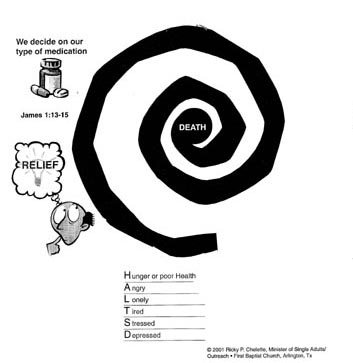
So we move from the bottom of the diagram to the thought for relief (the man and the bubble) to the thought of what we will do to medicate our pain and find relief (bottle of pills). When we decide to medicate our pain we go through some action (the runner) before we actually get to the medication.
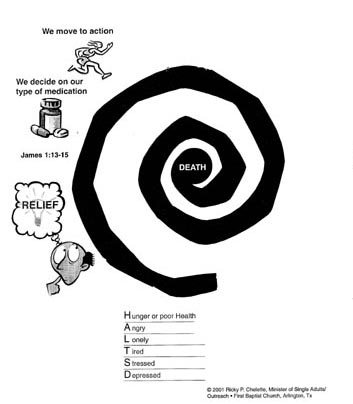
Oddly enough, even the action toward the intended medication, is somewhat medicinal itself. For example: If you are going to do the big M (masturbation) for your medication you might get undressed and lay in bed, or jump in a warm shower. If you are going to cruise P (internet Porn) on the internet you might get into something more comfortable and begin the search process. If you are going to act out with another or “cruise,” you might get cleaned up and put on some alluring clothing or other articles that would give clues to your intent. Basically, you go through some sort of ritual of preparation. It just doesn’t “happen.” However, we have done this ritual so many times that it feels quite automatic–we may not even realize that we are doing it. It is at this stage that most people tell me that they feel as though they really can’t help themselves–“it is like another person has taken over my body and I am just on autopilot.” In many ways, they really are.
I am convinced that once you move from thought to action, it is very difficult if not nearly impossible to stop the ultimate medication/action from taking place. Yes, of course God could intervene, but He has created us with free will and He rarely interferes with our willful decisions. During this phase of the cycle you are also likely to be producing adrenalin; a very strong chemical that makes a person’s heart rate increase, increases their blood pressure, and gives them a sense of invincibility.
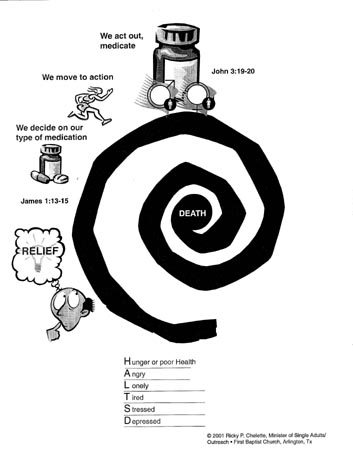
Finally, you carry out your medicative fix by doing the big M or having sex and achieving an orgasm in some way. When you do this, your brain produces a chemical called endorphin. This chemical is extremely strong, some say even ten times stronger than cocaine.
Every time you achieve an orgasm or act out in some way to achieve your medication, endorphins are produced and your body responds in a very predictable way. This is why you get that feeling of pleasure, euphoria, or peace when you orgasm (medicate). There are actually chemicals being produced in your brain that make you feel good. The preparation for the orgasm also can produce these chemicals (remember Pavlov’s salivating dogs?!) but not in the same quantity or intensity as the orgasm itself. (Now you are at the top of our diagram–medicine bottle)
I want you to think of your brain as a CD. Each time endorphins are produced, you burn another track on that CD. If you keep playing the same tune (producing the same chemical) over a period of months/years, you burn a rut in your CD and it is very, VERY difficult to get out of that rut. It is a universal, psychologically proven fact. We establish pathways in our brain that demand that we do certain things and get our fix. Thus, we continue to the cycle of medicating our hurts. . .
However, like every high, it is followed by an equally powerful low. The low begins as the chemicals in our brain are absorbed and assimilated into our bodies. We first begin to feel guilty (the lady that is crying on the diagram).
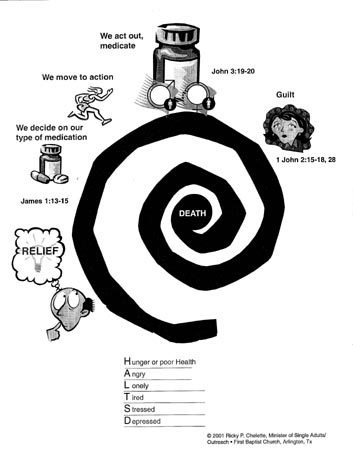
I believe that guilt and conviction are really good things. I see them as a way that the Spirit of God brings correction and discipline to our lives. However, many times we feel guilt, but we don’t confess and repent. We simply feel guilty. We do this because we think that God will not hear our prayers. . .again, for the thing that we seem to keep doing over and over. As a result, not too long after we feel guilt, Satan comes in and uses our sense of guilt to make us feel shame (the man that looks perplexed).
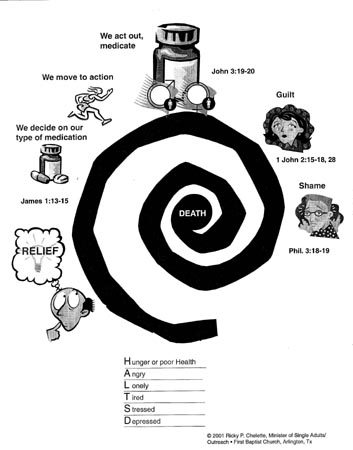
Shame, I believe, is of the devil. The difference between guilt and shame is that guilt is over our actions–things we do. Shame is feeling bad about who we are–our sense of self. Shame causes us to review the lies of Satan and our old tapes that tell us that, “I am worthless. God doesn’t really love me. I am a loser. No one will ever love me. I will never be rid of this sin. I am gay. Etc., etc.”
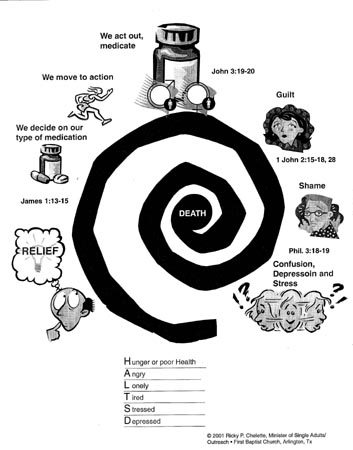 These self-loathing statements do nothing but drag us further down the cycle so that we become confused, stressed, angry, lonely, etc. (the confused triple-headed person). And where does that lead us?
These self-loathing statements do nothing but drag us further down the cycle so that we become confused, stressed, angry, lonely, etc. (the confused triple-headed person). And where does that lead us?
Back at the beginning of the cycle to keep repeating our sin again and again..
You should also notice that this spiral makes an inward progression that ends at a black hole. You see, what happens with our desire to medicate is that each time we do it, it takes a bit more stimulation to get us to the place that we have the same medicative results. We constantly need more. That is why the spiral is a spiral and not just a circle. It draws us in, deeper and deeper, until we reach the black hole–DEATH. James 1 says when sin is complete it will brings forth death: spiritual death, emotional death, and even physical death. The process is gradual most of the time, but it is guaranteed.
Take for example the person who starts out just looking at a “Men’s Health” magazine. Nothing wrong with that really. But there are some buff men that have their shirts off. They get excited about that, do a little lusting and masturbate and then they decide to find some porn on the internet. At first it is “mild porn” and then they have a need to find more explicitly sexual pornography, etc. Before you know it that is not enough for them and they search for chat rooms. They start chatting dirty and eventually they decide to call and talk with someone. They won’t meet. At least not this time….. But sooner or later chatting is not enough and they meet… and they have sex…. and you know the rest of the story….
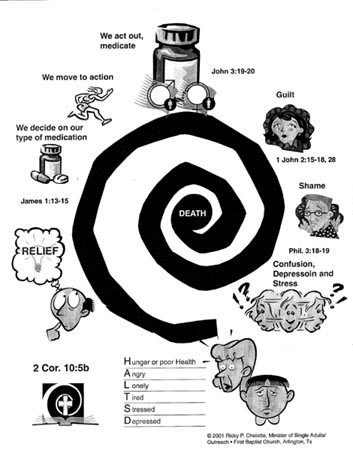
Our desire to medicate will take us further and further down this path of destruction. The results are guaranteed, but so is its destructive end.
So how do we break the cycle of sin in our lives?
I really think that there is only one opportunity for us to break the cycle. I think that we have to learn how to cope effectively and Biblically with our triggers.
If, when we realize that we are experiencing a trigger, we want relief (which we all do naturally) this is OK. However, this is where the discipline comes in. When we want relief we have to move from seeking to medicate our pain with acting out, to taking that need to medicate to the One who is the Great Physician–God. We have to go to Him, at this early stage, and tell Him what we are experiencing; what is going on with us; and ask Him for help. We have to do what 2 Cor. 10:5b says, “Take every thought captive to the obedience of Christ.” Every thought… not just some, but especially those that seek relief.
If we do this, we are able to kick ourselves out of the cycle of sin and find victory and freedom in Christ.
Is it that easy? Absolutely not. It is hard work. Many of you have not yet learned how to identify the triggers and that will be your first step. But with God’s help, it is doable.
Now, don’t think that this is just a struggler thing. It is not.
Here’s another example from my wife who does not struggle with SGA issues at all (thank God!). She is a nurse in ICU; a very stressful job. She is also a self-proclaimed chocoholic (any ladies relate to this?). Many times, when things are going bad at work (stress trigger), she says she can “hear” the candy machine calling her name (need for relief). She puts things in order with her patients (action/ritual) and sneaks out to the machine (more action) and eats a candy bar (medication). After she eats it she gets an insulin rush (sugar high) which makes her feel all euphoric and wonderful only to be followed by a sugar low which makes her feel guilty and convicted because she knows that she shouldn’t handle stress by eating. She then can easily slip into a shame cycle of self-loathing thinking that she is too fat (which she is not), out of control, etc. and the cycle begins again. [She told me I could share this as this diagram has helped her understand you and herself better.]
The same could be said of people who shop when they are triggered, spend money, drink coffee, become violent, use drugs or alcohol, etc. Same triggers, different courses of medication, different chemicals produced (sometimes), but all ending in the same results.
Well, I hope this makes some sense to you and is helpful to you in visualizing and getting a handle on what is taking place in your life. I would really encourage you to memorize the 2 Cor. 10:5b passage and the James 1:13-15 passage as these can help you in directing your thinking when you begin to think “RELIEF”–it will point you to Christ rather than to medication.








